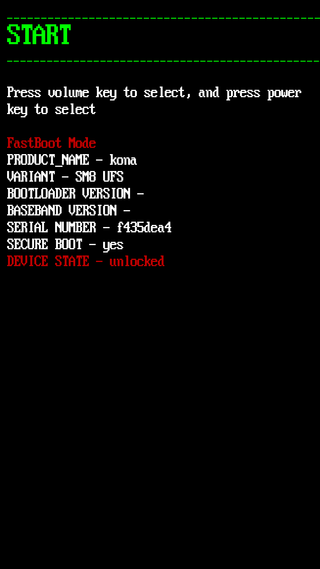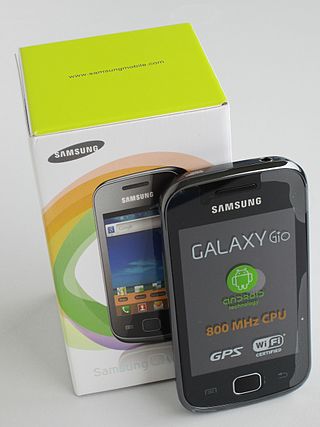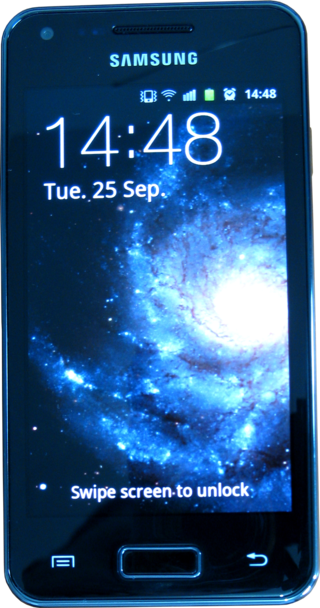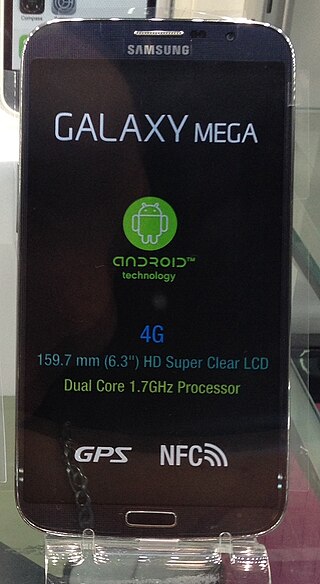A factory reset, also known as hard reset or master reset, is a software restore of an electronic device to its original system state by erasing all data, settings, and applications that were previously stored on the device. This is often done to fix an issue with a device, but it could also be done to restore the device to its original settings.

Fastboot is a communication protocol used primarily with Android devices. It is implemented in a command-line interface tool of the same name and as a mode of the bootloader of Android devices. The tool is included with the Android SDK package and used primarily to modify the flash filesystem via a USB connection from a host computer. It requires that the device be started in Fastboot mode. If the mode is enabled, it will accept a specific set of commands, sent through USB bulk transfers. Fastboot on some devices allows unlocking the bootloader, and subsequently, enables installing custom recovery image and custom ROM on the device. Fastboot does not require USB debugging to be enabled on the device. To use fastboot, a specific combination of keys must be held during boot.

The Nexus S is a smartphone co-developed by Google and Samsung and manufactured by Samsung Electronics for release in 2010. It was the first smartphone to use the Android 2.3 "Gingerbread" operating system, and the first Android device to support Near Field Communication (NFC) in both hardware and software.

The Android Debug Bridge is a programming tool used for the debugging of Android-based devices. The daemon on the Android device connects with the server on the host PC over USB or TCP, which connects to the client that is used by the end-user over TCP. Made available as open-source software under the Apache License by Google since 2007, features include a shell and the possibility to make backups. The adb software is available for Windows, Linux and macOS. It has been misused by botnets and other malware, for which mitigations were developed such as RSA authentication and device whitelisting.

Samsung Galaxy Gio (GT-S5660) is a smartphone manufactured by Samsung and running the Android operating system.

The Samsung Captivate Glide (SGH-i927) as it is called in the United States, and sold as the Samsung Galaxy S Glide (SGH-i927R) in Canada, is the first physical QWERTY Galaxy S class smartphone running under the Android operating system to be released by Samsung for AT&T (US) and Rogers Wireless (Canada).

The Samsung GT-I9070 Galaxy S Advance is an Android smartphone manufactured by Samsung Electronics. It was announced on 30 January 2012 and released in April 2012 as an "advanced" variant to the original Galaxy S.

The Samsung Galaxy S4 is an Android smartphone produced by Samsung Electronics as the fourth smartphone of the Samsung Galaxy S series and was first shown publicly on March 14, 2013, at Samsung Mobile Unpacked in New York City. It is the successor to the Galaxy S III, which maintains a similar design, but with upgraded hardware, more sensors, and an increased focus on software features that take advantage of its hardware capabilities—such as the ability to detect when a finger is hovered over the screen, and expanded eye tracking functionality, it was released the previous year. A hardware variant of the S4 became the first smartphone to support the emerging LTE Advanced mobile network standard. The T-Mobile version of the Galaxy S4, named the model (SGH-M919), was released the same month. The phone's successor, the Samsung Galaxy S5, was released the next year.

The Samsung Galaxy Mega is an Android-based phablet that was manufactured and released by Samsung. It was announced on April 11, 2013. The original model featured a 6.3 in (160 mm) screen, though a revised version was released with a 5.8 in (150 mm) screen. It has a 1,280×720 screen, a dual-core 1.7 GHz processor and an 8-megapixel camera. The phone runs Android 4.2.2 "Jelly Bean" software, and internal storage is 8 or 16 GB.

The Samsung Galaxy A5 (2015) or Samsung Galaxy A5 2015 Edition is an Android smartphone produced by Samsung Electronics. Serving as a premium upper mid-range device, it was introduced on 30 October 2014, along with the smaller and related Samsung Galaxy A3 (2015) and larger Samsung Galaxy A7 (2015) introduced later in January 2015. The Samsung Galaxy A5 (2016) is a successor to the Samsung Galaxy A5 (2015) edition, featuring a revised metal and glass build that debuted with the Galaxy S6.

Odin is a utility software program developed and used by Samsung internally which is used to communicate with Samsung devices in Odin mode. It can be used to flash a custom recovery firmware image to a Samsung Android device. Odin is also used for unbricking certain Android devices. Odin is the Samsung proprietary alternative to Fastboot.
The Samsung Galaxy Mega 2 is an Android smartphone/tablet computer hybrid manufactured by Samsung, the successor to the Samsung Galaxy Mega. It was released in September 2014.

The Samsung Galaxy S7, Samsung Galaxy S7 Edge and Samsung Galaxy S7 Active are Android-based smartphones manufactured, released and marketed by Samsung Electronics. The S7 series serves as the successor to the Galaxy S6, S6 Edge, S6 Edge+ and S6 Active released in 2015. The S7 and S7 Edge were officially unveiled on 21 February 2016 during a Samsung press conference at Mobile World Congress, with a European and North American release on 11 March 2016. The S7 Active was unveiled on 4 June 2016, and released on AT&T in the United States on 10 June 2016.

The Samsung Galaxy J7 (2016) is an Android-based mid-range smartphone produced by Samsung Electronics in 2016 and is either based on the Qualcomm Snapdragon 615 or Exynos 7870 chipset.

The Samsung Galaxy A90 5G is an Android phablet manufactured by Samsung Electronics as part of its fifth-generation Galaxy A series lineup. It comes with Android 9 (Pie) with Samsung's One UI skin, 6/8GB RAM, 128 GB of internal storage, and a 4500 mAh battery. It is Samsung's first mid-range smartphone to support 5G network connectivity. The Galaxy A90 5G was first unveiled in South Korea on September 3, 2019.

The Samsung Galaxy S21 is a series of high end Android-based smartphones designed, developed, marketed, and manufactured by Samsung Electronics as part of its Galaxy S series. They collectively serve as the successor to the Samsung Galaxy S20 series. The first three smartphones were unveiled at Samsung's Galaxy Unpacked event on 14 January 2021, while the Fan Edition model was unveiled at Samsung's CES on 3 January 2022.

Bootloader unlocking is the process of disabling the bootloader security that makes secure boot possible. It can make advanced customizations possible, such as installing a custom firmware. On smartphones this can be a custom Android distribution or another mobile operating system. Some bootloaders are not locked at all, others can be unlocked using a standard command, others need assistance from the manufacturer. Some do not include an unlocking method and can only be unlocked through a software exploit.
The booting process of Android devices starts at the power-on of the SoC and ends at the visibility of the home screen, or special modes like recovery and fastboot. The boot process of devices that run Android is influenced by the firmware design of the SoC manufacturers.

The Samsung Galaxy A23 is an Android-based smartphone designed, developed and marketed by Samsung Electronics as a part of its Galaxy A series. The phone was announced on March 4, 2022, alongside the Galaxy A13.

The Samsung Galaxy S22 is a series of Android-based smartphones designed, developed, manufactured, and marketed by Samsung Electronics as part of its Galaxy S series. Unveiled at Samsung's Galaxy Unpacked event on 9 February 2022.


















